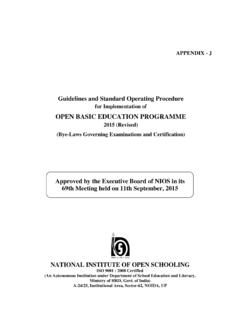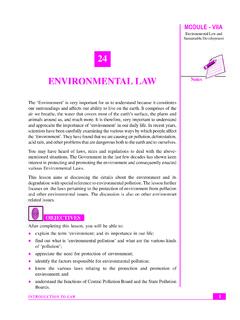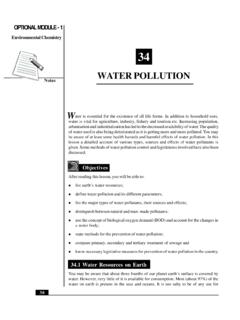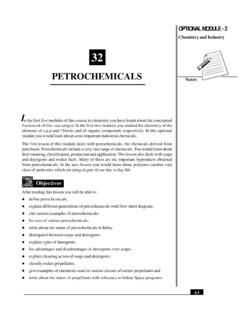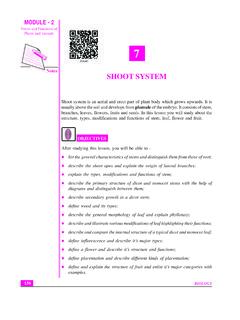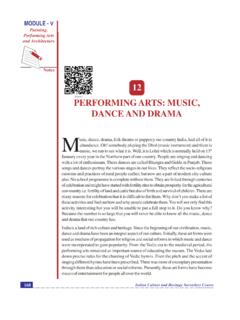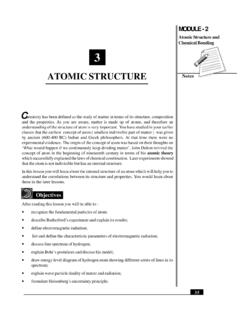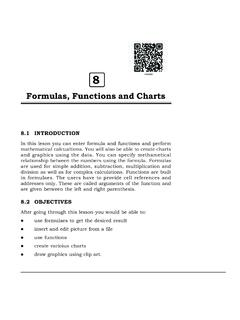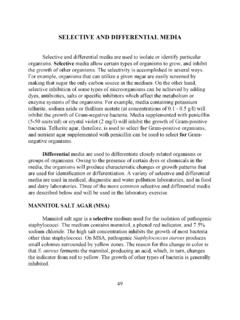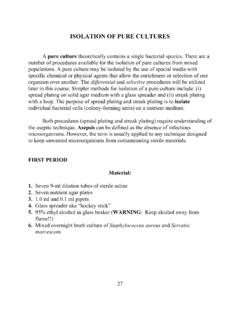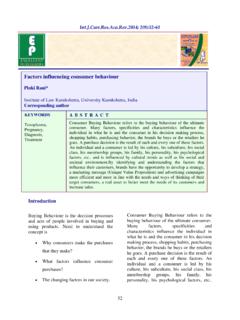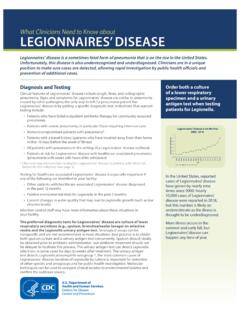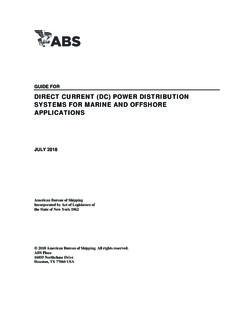Transcription of 10 METHODS OF ISOLATION OF - National Institute of Open ...
1 109 METHODS of ISOLATION of BacteriaMICROBIOLOGYMODULEM icrobiologyNotes10 METHODS OF ISOLATION INTRODUCTIONWe have learned in earlier chapters that there exist so many bacteria that causehuman now our task is to isolate these bacteria and identify them. Theidentification is required so as to cure the illness or the infection caused due tothese bacteria, using appropriate antibiotics. Identification also holds significancefor epidemiological chapter would focus on various METHODS used for ISOLATION of in subsequent chapters we would learn about identification of bacteria andthe ways to contain the infections caused by reading this chapter, you will be able to :zExpalin the steps involved in the ISOLATION of the significance of Specimen the significance of Preservation and transportation of the role of microscopy in ISOLATION of various METHODS for ISOLATION of ISOLATION OF BACTERIAI solation of bacteria forms a very significant step in the diagnosis andmanagement of the illness.
2 ISOLATION of bacteria involves various steps zSpecimen collectionzPreservation and transportation of specimenMICROBIOLOGYMODULEM ethods of ISOLATION of BacteriaMicrobiology 110 NoteszMicroscopic examination of samplezVarious METHODS used for ISOLATION of bacteriaSpecimen collectionMany different specimens are sent for microbiological examination frompatients with suspected bacterial infection. Common specimens include urine,faeces, wound swabs, throat swabs, vaginal swabs, sputum, and blood. Lesscommon, but important specimens include cerebrospinal fluid, pleural fluid,joint aspirates, tissue, bone and prosthetic material ( line tips).Some types of specimen are normally sterile blood, CSF. These samples areusually obtained via a percutaneous route with needle and syringe, usingappropriate skin disinfection and an aseptic technique.
3 The culture of bacteriafrom such specimens is usually indicative of definite infection except if they areskin contaminants (bacteria inhabitants of normal skin).Fig. : Universal contrast, many microbiological specimens are obtained from non-sterile vaginal or throat swabs, urine sample, stool sample. Such samples oftencontain bacteria of no clinical relevance in addition to possible pathogens,making the interpretation of culture results more difficult. In general it ispreferable to send samples from sterile sites if is preferred to obtain the samples for bacteriological culture before antibiotictherapy is started. This maximizes the sensitivity of the investigations andreduces false-negative results. Similarly, samples of tissue or pus are preferredover swabs, to maximize the recovery of bacteria in the must be accurately labelled and accompanied by a properlycompleted requisition form, indicating the nature of the specimen, the date ofsample collection, relevant clinical information, the investigations required, anddetails of antibiotic therapy, if any.
4 111 METHODS of ISOLATION of BacteriaMICROBIOLOGYMODULEM icrobiologyNotesThis allows the laboratory to perform the correct range of tests, and helps in theinterpretation of results and reporting. Along with clinical specimens, medicalmicrobiology laboratories also process samples of food, water and otherenvironmental samples ( air sampling from operating theatres) as part ofinfection control samplesCertain bacterial infections are a particular hazard to laboratory staff, andspecimens that might contain these pathogens should be labelled as high risk to allow for additional safety measures if necessary. For example - blood culturesfrom suspected typhoid (Salmonella typhi) or brucellosis (Brucella species), andsamples from suspected Mycobacterium and Transport of specimenMost specimens are sent to the laboratory in sterile universal containers.
5 Swabsare placed in a suitable transport medium (eg. charcoal medium) otherwise itleads to false negative : Charcoal laden transport mediaSpecimens should be transported as soon as possible to the laboratory. In casea delay is anticipated the specimen should be stored at 4 transport is necessary in order to:(i) Preserve the viability of the delicate bacteria, such as Streptococcuspneumoniae or Haemophilus influenzae (delays in processing can causefalse-negative culture results);(ii) Minimize the multiplication of bacteria ( coliforms) within specimensbefore they reach the laboratory. In particular urine and other specimensthat utilize a semiquantitative culture technique for thier detection, asdelays in transport can give rise to falsely high bacterial counts when thespecimen is Gram stain helps with the visualization of bacteria, and gives an indicationof the type of bacteria present, based on the shape of the bacteria and the stainingMICROBIOLOGYMODULEM ethods of ISOLATION of BacteriaMicrobiology 112 Notesproperties (Gram positive: purple; Gram negative: pink/red).
6 A Gram stain alsohelps to identify mixtures of bacteria, helps to determine the appropriate rangeof agar plates to be used for subsequent culture, and helps with the interpretationof culture : Gram positive cocci Fig. : Gram negative bacilliFor liquid specimens CSF, the sample is first centrifuged to concentrate anybacterial cells in the deposit, and Gram stain and culture is performed from thedeposit after the supernatant is decanted. This helps increase the sensitivity ofboth microscopy and (ZN) stain is used to demonstrate the presence of can also be visualized using the fluorescent dye auramine and afluorescence microscope. Direct immunofluorescence is employed to detectcertain pathogens ( Legionella, Pneumocystis) using specific antibodiesconjugated to a fluorescent microscopic technique is dark ground microscopy.
7 This is mainly usedto detect the thin spirochaetal cells of Treponema pallidum (syphilis bacteria).INTEXT QUESTIONS Specimens that contain pathogens which are hazardous to laboratory staffshould be labeled as ..2. Swabs are sent to laboratory in .. medium 113 METHODS of ISOLATION of BacteriaMICROBIOLOGYMODULEM icrobiologyNotes3. If delay is anticipated in transporting the specimen, it should be stored temperature4.. gives an indication of bacteria present in the sample5.. stain is used in demonstration of mycobacteria6.. microscopy is used to detect syphilis METHODS OF ISOLATION OF BACTERIAM ethods of ISOLATION of bacteria can be broadly classified into twozCulture methodszOn Solid mediazOn Liquid mediazAutomated systemszNon-culture methodsCulture methodsThe specimens received in the laboratory are plated on the culture media.
8 Theappropriate culture media is selected depending upon the bacteria suspected. Thefollowing precautions need to be taken into consideration when the culturemethods are processedzOptimal atmospheric conditionszOptimal temperaturezGrowth requirement of the bacteriaAtmospheric conditions:Colonies of bacteria are usually large enough to identify after 18 24 hours ofincubation (usually at 37 C), but for some bacteria longer incubation times arerequired (from 2 days to several weeks). Culture plates are incubated (1) in air,(2) in air with added carbon dioxide (5%), (3) anaerobically (without oxygen)or (4) micro-aerophilically (a trace of oxygen) according to the requirements ofthe different types of bacteria that may be present in case of Mycobacteria especially the scotochromogen the culture bottles areplaced in dark or the bottles are covered with black paper and kept for incubationat 37 :Most of the bacteria requires a temperature of 37 C for optimal growth.
9 Thistemperature is provided placing the inoculated culture plates in the incubator setat 37 C of ISOLATION of BacteriaMicrobiology 114 NotesFig. : IncubatorGrowth requirement of the bacteriaDifferent bacteria have different growth requirements. For eg Streptococcuspneumoniae requires factor V and factor X for its growth, which are found inchocolate agar. Thus for sample suspected of S. pneumoniae the samples areplated on chocolate agar. Similarly depending upon the growth requirementsthe appropriate culture media are QUESTIONS .. & .. METHODS are commonly used METHODS forbacterial isolation2. Colonies of bacteria can be identified after .. hours of incubation3. The optimum temperature most bacteria require to grow are ..4. Chocolate agar has .. & .. which is used in the diagnosisof streptococci Pneumonia 115 METHODS of ISOLATION of CULTURE ON SOLID MEDIAThe principal method for the detection of bacteria from clinical specimens is byculture on solid culture media.
10 Bacteria grow on the surface of culture mediato produce distinct bacteria produce different but characteristic colonies, allowing forearly presumptive identification and easy identification of mixed cultures. Thereare many different types of culture media. Agar is used as the gelling agent towhich is added a variety of nutrients ( blood, peptone and sugars) and otherfactors ( buffers, salts and indicators).Some culture media are nonselective ( blood agar, nutrient agar) and thesewill grow a wide variety of bacteria. While some MacConkey agar are moreselective (in this case through the addition of bile salts selecting for the bile-tolerant bacteria found in the large intestine such as Escherichia coli andEnterococcus faecalis). MacConkey agar also contains lactose and an indicatorsystem that identifies lactose-fermenting coliforms ( Escherichia coli,Klebsiella) from lactose-non fermenting coliforms ( Morganella Salmonella).
